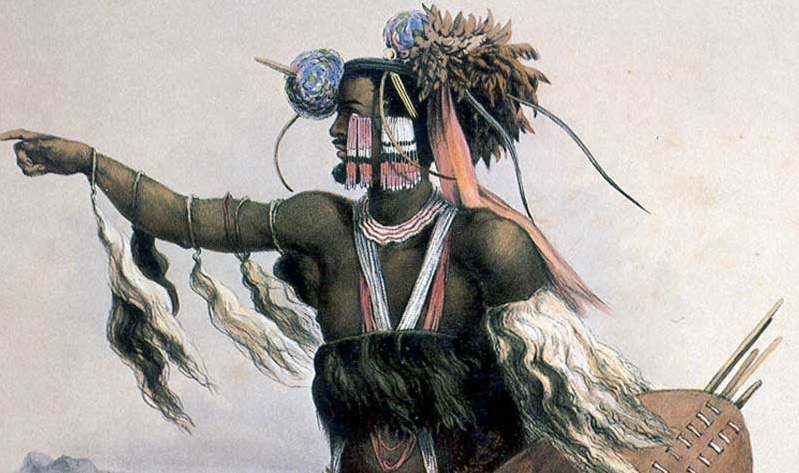By Thomas Sibanda
King Soshangana was born in present day KwaNongoma in KwaZulu to Zikode kaGasa, a chief of the Ndwandwe empire under King Zwide kaLanga. The Gasa occupied the Mkhuze region around the eTshaneni mountain.
After the collapse of the Ndwandwe empire, Soshangana, along with his four brothers followed the example of other Ndwandwe parties by fleeing King Shaka. They took a route along the eastern foothills of Lubombo through Mngomezulu to the upper Tembe River.
In the Tembe area, King Soshangana lived for about five years, fortifying his group by constant raids. In about 1825, he crossed the Tembe River and marched north-west. Between 1825 and 1827 he lived on a tributary of the Nkomati River north of present-day Maputo.
King Soshangana defeated almost all the Ronga clans of the vicinity of Delagoa Bay without encountering any resistance and raided their cattle. Their young women were taken captive, and the defeated young men were taken up in his army.
His following was reinforced by many Ndwandwe refugees after the defeat of Sikhunyani by Shaka in 1826. King Soshangana and his people stayed in the region of Delagoa Bay until 1828 when he defeated King Shaka’s army at Bileni.
After a few years, King Zwangendaba returned from the north and joined Soshangana. After about two years together, mutual jealousies arose, and King Zwangendaba was forced to break ranks and carve his kingdom.
King Soshangana’s residence was in the lower Limpopo Valley. His capital was located at Ekuphumuleni near present-day Chaimite in the Gaza province of Mozambique.
From there, Soshangana sent his regiments in different directions to subdue local people. Using the military tactics which they had learned in Nguniland they conquered all people they attacked.
He defeated the Zulu armies in 1828. In the same year, King Shaka was murdered by his half-brother. King Soshangana and his followers thereafter, established themselves on the fertile lowlands of the Lower Limpopo River in Bileni without any fear of Zulu attacks.
Soshangana and his group subjugated and incorporated the indigenous Tsonga, Shongonono, Ngomane, Ndau, Hlengwe, Nyai, Rhonga, Manyika, Tonga, Senga and Chopi tribes. Young men were incorporated into the regiments of his army, the women taken as wives and beasts as provisions.
This incorporation of various people groups brought into existence the Gasa empire, which Soshangana named after his grandfather Gasa. This blend of people groups was known as amaShangana, loosely meaning Soshangana’s people.
On the Save River in present-day Zimbabwe, Soshangana violently subdued local groups after settling there in 1836. There he met King Zwangendaba again and they fought each other for three to four days until eventually, Zwangendaba fled to present-day Bulawayo.
After this battle, Soshangana settled further to the eastern side on the high lands of central Save. Before long he discovered that he was not the only Nguni leader in the area. Nxaba had established himself at the Buzi River in the eastern highlands as well.
Nxaba and his followers were also attacked and forced to flee. This victory enabled Soshangana to expand his kingdom. He then subjugated the people groups between the Zambezi and Inhambane and subsequently conquered the whole area south of Delagoa Bay.
In 1838, as a result of the smallpox epidemic, Soshangana lost many of his warriors and was forced to return to his earlier home, Bileni in the Limpopo valley. He left his son Mzila under control of the entire tributary region north of the Zambezi.
When King Soshangana returned to settle in the Limpopo valley, he brought not only all the Tsonga chiefdoms of the interior under his control, but he also subjected many of the Tonga in the immediate region of Inhambane.
The Gasa empire grew because of the conquests of large populations of these groups. These people groups became known as amaShangana as distinguished from the ruling Nguni aristocrats. The Nguni intermarried with these people groups but failed to impose their language.
The last years of Soshangana’s reign were spent stabilising and enforcing his power by sending his regiments out as far as the Zambezi River yearly to collect taxes and tribute. Soshangana died in 1858 at his residence near Chaimite.
Soshangana‘s remains were taken to eTshaneni Mountain in Zululand where he was buried. Under King Mzila and his successor Ngungunyane, the Gasa empire was embroiled in the slave trade. The Gasa kingdom raided for slaves to sell to the Portuguese and various plantations.
The Gasa kingdom under King Ngungunyane was overthrown by the Portuguese in 1897, being the last African kingdom in Southern Africa to fall under colonial rule.

